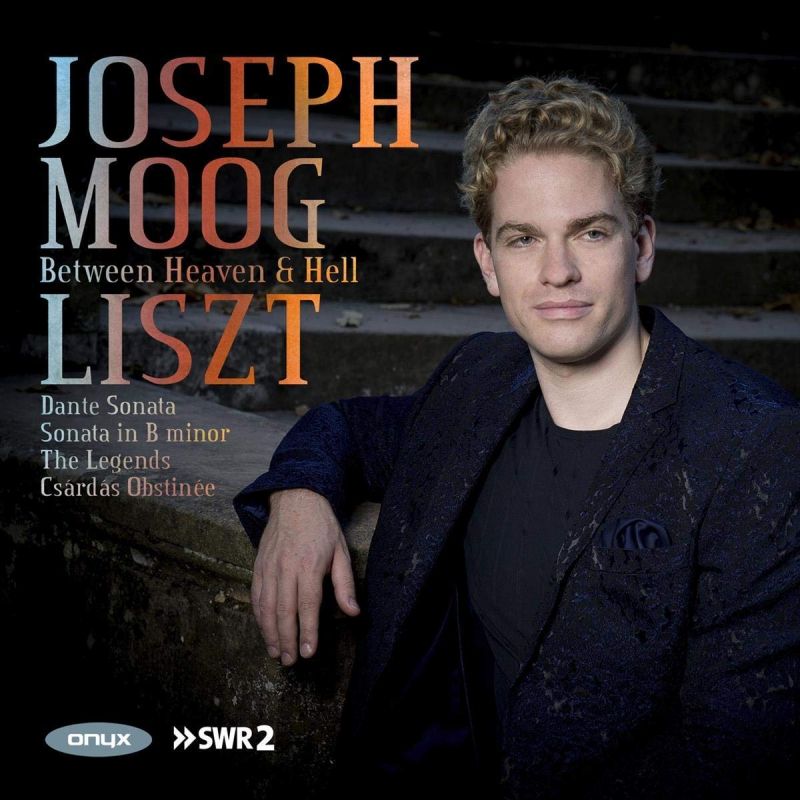LISZT Piano Sonata. 2 Legendes (Joseph Moog)
View record and artist detailsRecord and Artist Details
Composer or Director: Franz Liszt
Genre:
Instrumental
Label: Onyx
Magazine Review Date: 12/2019
Media Format: CD or Download
Media Runtime: 63
Mastering:
DDD
Catalogue Number: ONYX4195

Tracks:
| Composition | Artist Credit |
|---|---|
| Sonata for Piano |
Franz Liszt, Composer
Franz Liszt, Composer Joseph Moog, Piano |
| (2) Légendes |
Franz Liszt, Composer
Franz Liszt, Composer Joseph Moog, Piano |
| Années de pèlerinage année 2: Italie, Movement: Après une lecture du Dante, fantasia quasi sonata |
Franz Liszt, Composer
Franz Liszt, Composer Joseph Moog, Piano |
| (2) Csárdás, Movement: Csárdás obstiné |
Franz Liszt, Composer
Franz Liszt, Composer Joseph Moog, Piano |
Author: Patrick Rucker
On a purely technical level, Moog’s interpretation of Liszt’s B minor Sonata, a work that poses rigours for pianists comparable to the challenges of the role of Hamlet for actors, is bound to amaze. Doubtless some pianophile, stopwatch in hand, will clock Moog’s octaves as faster than the 1932 Horowitz recording. However, for elucidation of the Sonata’s deeper musical values – its organic structure, the inventive permutations of thematic material, the sustained aura of ambivalence previously unknown in music – it’s probably best to look elsewhere.
Bluntly put, Moog seems incapable of curbing his mania for speed. He achieves moments approaching poetic eloquence, only to dash them to bits with obtrusively frenetic passagework of such velocity that the ear is scarcely able to follow. His habitual pendulum-swing between slow and very, very fast renders the inherent harmonic tensions of the score moot. The Quasi adagio becomes untethered from a basic underlying pulse, wandering aimlessly. Somnolence is dispelled by the rude fugato, its hectic progress marked with insensate clatter that grows so numbingly relentless that, by the time the lofty peroration and mysterious denouement arrive, one is past caring.
Liszt reversed the Sonata quasi una fantasia appellation Beethoven used for his Op 27 Sonatas to Fantasia quasi sonata as the subtitle of the Dante Sonata, emphasising the fantasy elements of the work. In a piece replete with rhetorical devices borrowed from Italian opera, Moog seems all but impervious to the contours of declamation, the phrase shapes, caesuras and emphases on which the work depends. The result is a vague series of tableaux, areas of technical focus that, in and of themselves, convey little meaning, cohesion or sense of fantasy.
In the second of the two Légendes, it sounds as though St Francis of Paola exercised poor judgement in crossing the straits of Messina during a raging cyclone. Meanwhile, back in Hungary, it was clearly an off-night at the csárda, or roadside inn, with revellers coming to a virtual full stop six times before accelerating in tedious predictability during the 336 bars of Csárdás obstinée.
Discover the world's largest classical music catalogue with Presto Music.

Gramophone Digital Club
- Digital Edition
- Digital Archive
- Reviews Database
- Full website access
From £8.75 / month
Subscribe
Gramophone Full Club
- Print Edition
- Digital Edition
- Digital Archive
- Reviews Database
- Full website access
From £11.00 / month
Subscribe
If you are a library, university or other organisation that would be interested in an institutional subscription to Gramophone please click here for further information.




